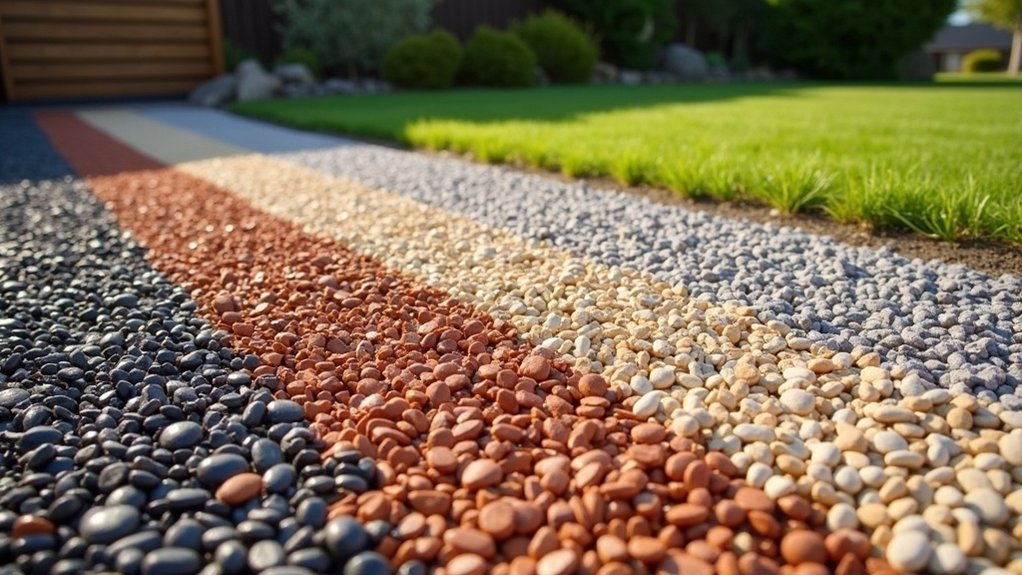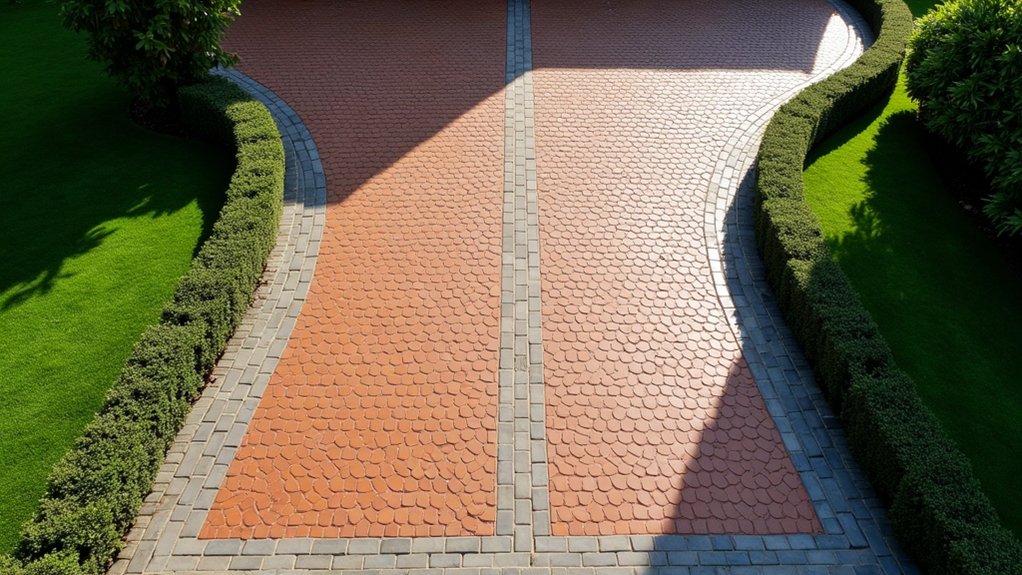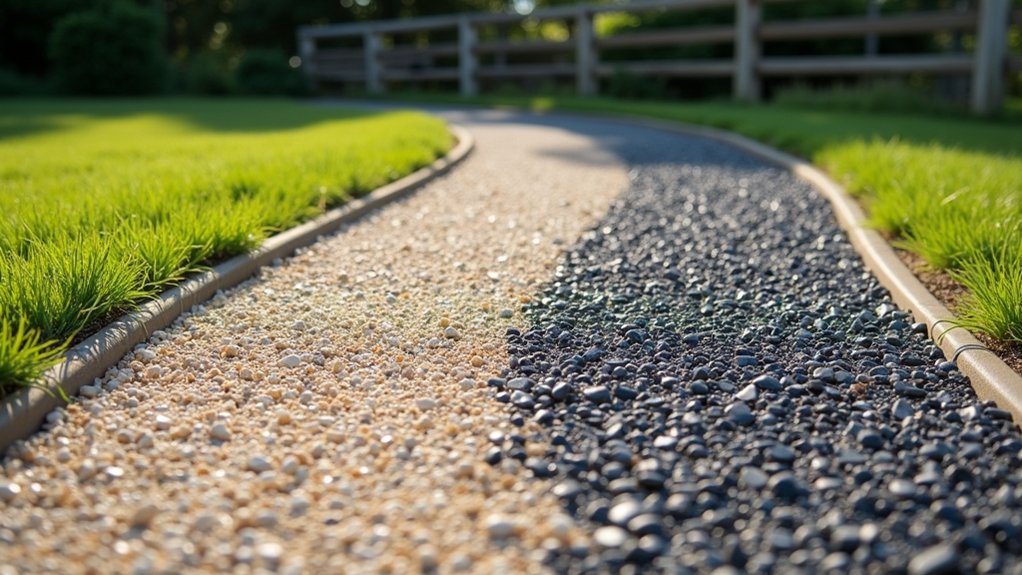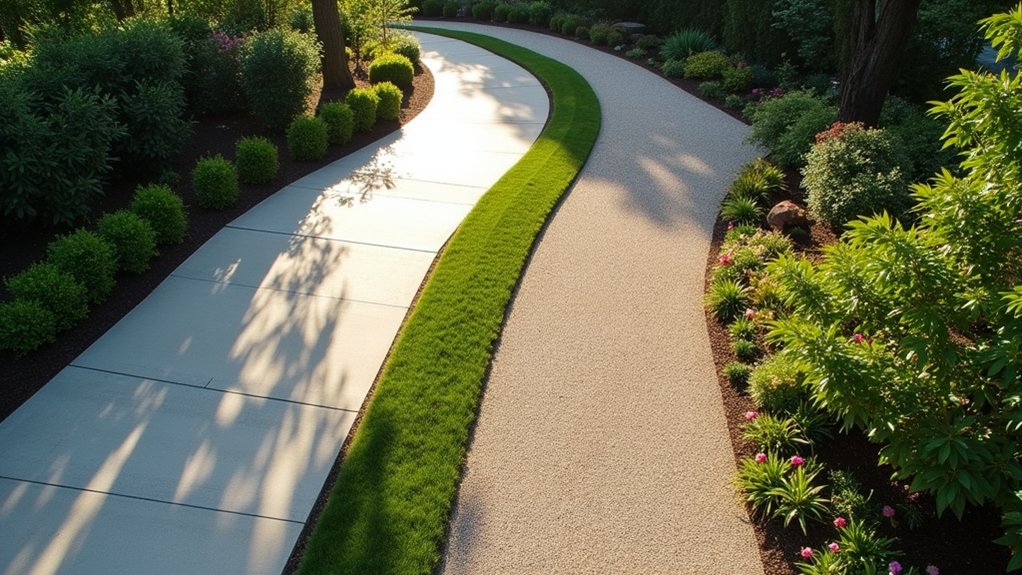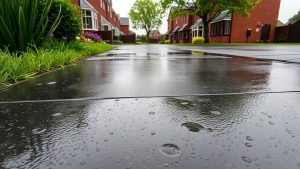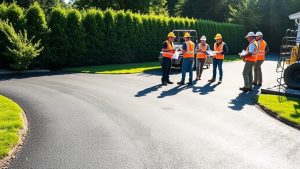Choosing the right colour gravel for your driveway requires a blend of style and practicality. Think about the colours of your home’s exterior; warm-toned gravels work well with traditional styles, while cooler shades suit contemporary looks. Lighter colours improve visibility and reflect heat, which can be advantageous in warmer areas. On the other hand, earthy tones can effectively disguise dirt and are generally easier to maintain. Also, consider how seasonal changes might affect the gravel’s appearance. Take the time to select gravel that meets your needs and boosts your home’s curb appeal.
Table of Contents
ToggleKey Takeaways
- Consider the colour of your home’s exterior; warm tones pair well with earthy gravel, while cooler shades complement grey or black gravels for a unified appearance.
- Opt for lighter-coloured gravel to improve visibility at night and enhance safety, particularly in dimly lit areas.
- Choose gravel colour based on your climate; lighter colours reflect heat in warmer regions, whereas darker shades can assist in melting snow during colder months.
- Select gravel colours that can effectively hide dirt and stains, minimising maintenance and keeping your driveway looking tidy.
- Incorporate patterns or two-tone blends in your gravel layout to introduce visual interest and reduce monotony, boosting your home’s curb appeal.
Understanding Different Types of Gravel
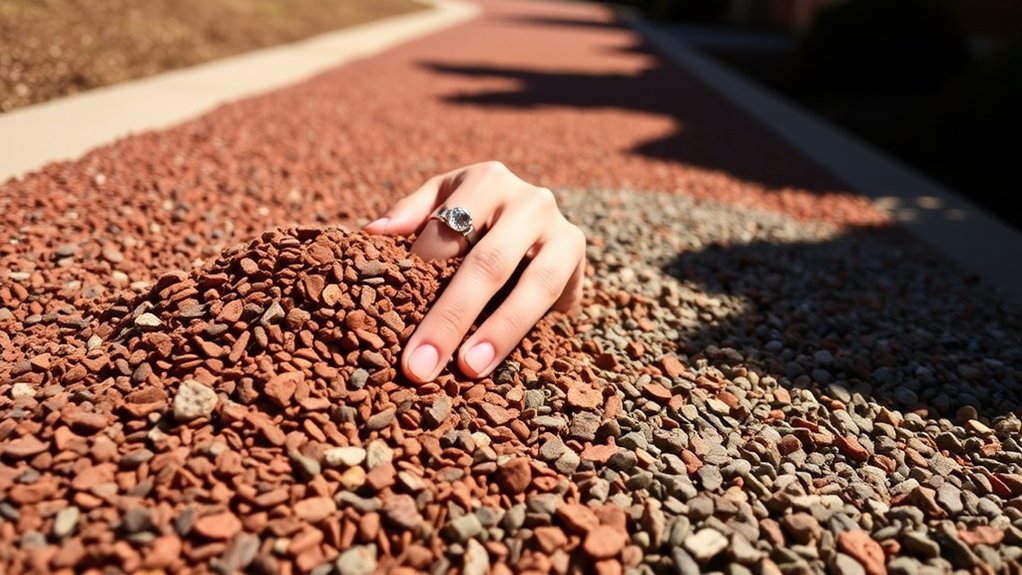
Choosing the right gravel for your driveway can significantly impact its performance and appearance. Here’s a quick overview of the various types available:
- Crushed Stone: This type has angular edges that improve stability and drainage, making it perfect for areas with heavy traffic. It can handle moderate traffic from heavy vehicles, ensuring durability.
- Quarry Process: A mix of crushed stone and dust, this option creates a compact and stable surface, ideal for driveways.
- Pea Gravel: Smooth and rounded, pea gravel offers excellent drainage but may shift over time, so it’s best for light traffic areas.
- River Rock: While aesthetically pleasing, river rock is less stable and mightn’t be suitable for high-traffic driveways.
- Marble Chips: These provide a durable and attractive finish but can be on the pricier side.
Selecting the appropriate gravel type ensures your driveway meets your needs and lasts for years to come.
Considering Color Based on Home and Landscape
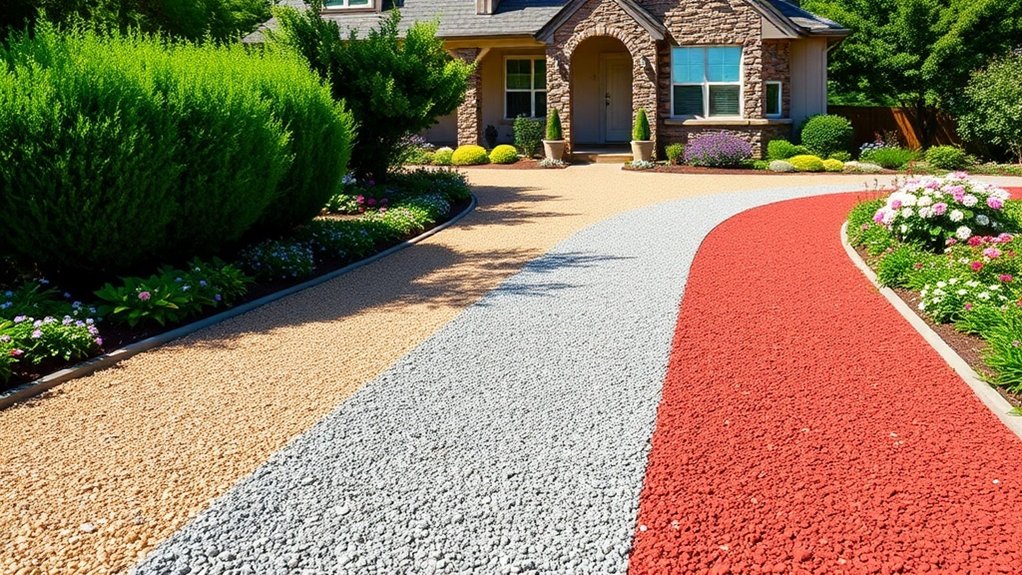
When selecting gravel for your driveway, consider how the colour complements your home’s exterior and garden. Lighter shades can blend well with traditional styles, while earthy tones work nicely with warm-toned houses, creating a unified appearance. Additionally, using colored driveway gravel can enhance the overall aesthetic appeal of your property.
Home Exterior Compatibility
Selecting the right gravel colour for your driveway can significantly enhance the look of your home and garden.
It’s important to achieve colour harmony with your home’s exterior. Here are a few tips:
- Warm Tones: If your home has warm hues, such as beige or red brick, consider earthy gravel shades like tan or brown to complement those tones.
- Cool Exteriors: For homes with cool colours, such as grey or white, choose gravel in shades of grey, white, or black to maintain a modern, sleek appearance. Additionally, pea gravel in various colors, including cream and black, can be particularly effective in these settings.
- Bold Contrasts: Using contrasting gravel—light gravel for dark homes or vice versa—can create a striking effect and improve your home’s curb appeal.
Keep these suggestions in mind for a driveway that enhances your overall property.
Landscape Integration Techniques
To create a harmonious connection between your driveway and the surrounding landscape, focus on both aesthetics and functionality.
Light-toned gravels can blend smoothly into traditional settings, while multi-toned options add depth by reflecting nature’s diversity. Use contrasting colours to draw attention to features like flower beds or pathways, which can enhance visual appeal. Warm hues work well with autumn leaves, whereas cooler tones suit modern designs.
Consider how seasonal changes affect your choice: lighter gravels can brighten shaded areas, while darker shades can make vibrant plants stand out.
Functional Aspects of Gravel Color Selection
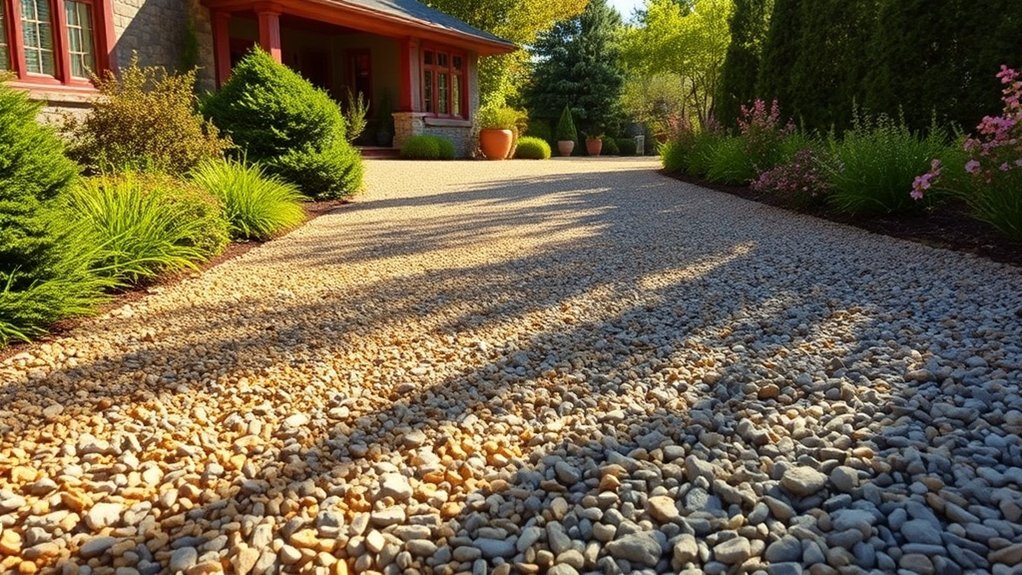
When choosing gravel colour, it’s not just about looks – it significantly impacts your driveway’s functionality and durability. Here are three important factors to consider:
1. Heat Management: Light-coloured gravel reflects sunlight, keeping your driveway cooler, which is beneficial in warmer climates.
Conversely, darker shades absorb heat, which can lead to deterioration over time.
2. Safety & Visibility: Lighter colours enhance visibility at night and provide better contrast against the surrounding area, improving safety for both pedestrians and vehicles.
3. Maintenance: Earthy tones can disguise dirt and stains, meaning less frequent cleaning.
Opting for colours that complement your surroundings helps your driveway blend in while still being practical.
Choosing the right gravel colour is essential for both aesthetics and the long-term performance of your driveway.
Aesthetic and Environmental Effects of Gravel Choices
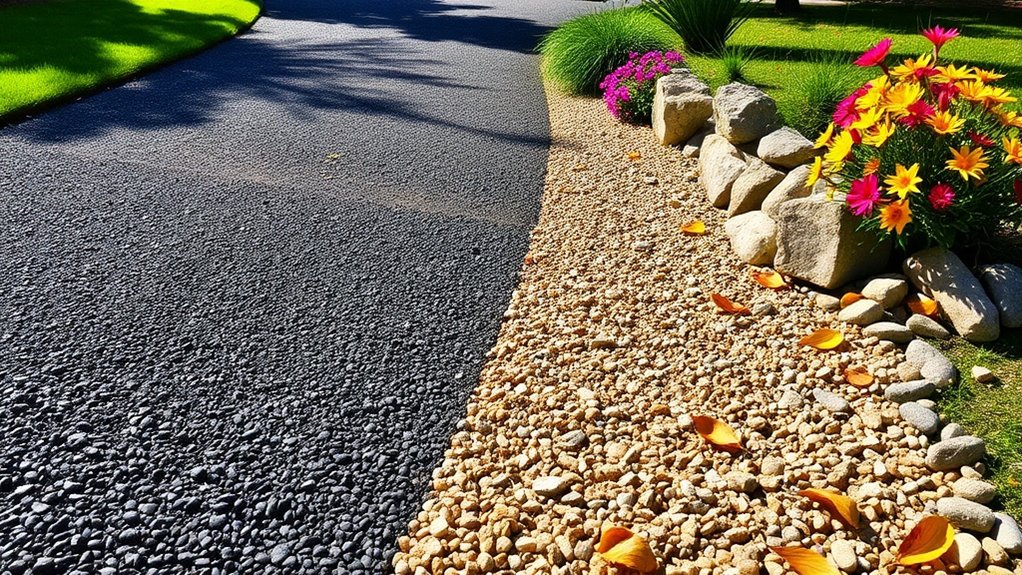
When considering the aesthetic and environmental effects of gravel choices, the impact goes beyond just looks.
Selecting light-coloured gravels creates a cohesive look with traditional homes, blending nicely into your garden. Warm earth tones enhance rustic charm, while bold colours like reds and blues can serve as eye-catching features. This visual harmony boosts your property’s overall appeal.
On the environmental side, natural-coloured gravels encourage rainwater infiltration, which helps recharge groundwater and supports sustainability. Additionally, using permeable surfaces like resin-bound driveways can further enhance your landscape by allowing efficient water drainage and reducing flooding risks.
Lighter gravels also reflect sunlight, possibly reducing heat build-up in the area. By choosing the right gravel colour, you not only enhance your driveway’s visual appeal but also make a positive contribution to your home’s ecological footprint, ensuring a beautiful and sustainable outdoor space.
Evaluating Climate and Regional Suitability
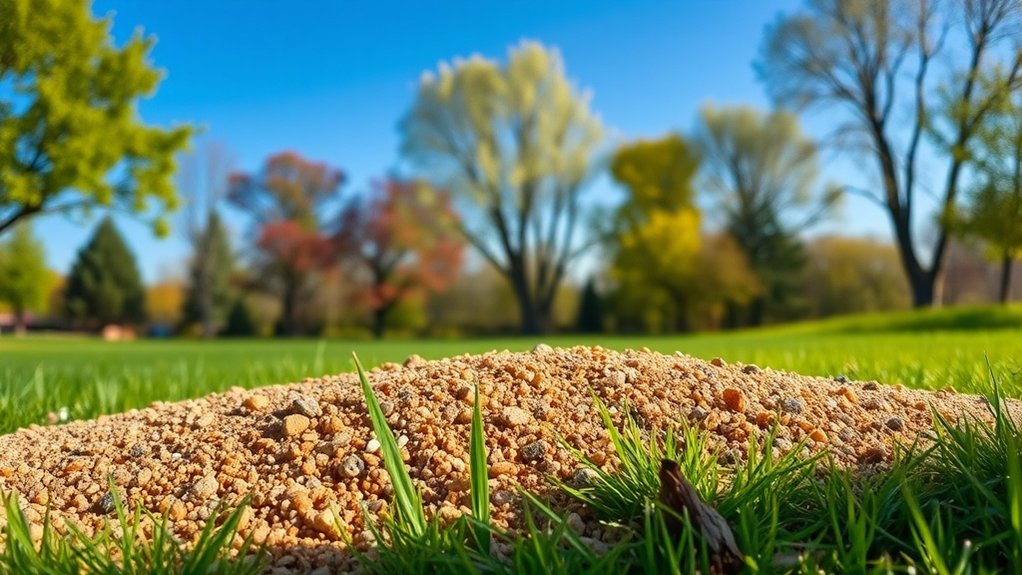
Choosing the right gravel for your driveway goes beyond just looks; it must also fit your local climate and region. Here are three important factors to consider:
- Climate Influence: Dark gravel absorbs heat, which is helpful in cooler areas for quicker snow melting. Conversely, light gravel reflects sunlight, keeping driveways cooler in hotter climates.
- Drainage: In areas with heavy rainfall, select gravel types like pea gravel or crushed stone that provide excellent drainage to prevent erosion and water pooling.
- Durability: Pick materials suited to your local weather. For instance, marble chips are great for colder climates as they resist freeze-thaw damage, while caliche works well in dry regions but is less durable in wet conditions.
Make your choice wisely to ensure long-lasting functionality and comfort!
Practical Tips for Choosing Gravel Color
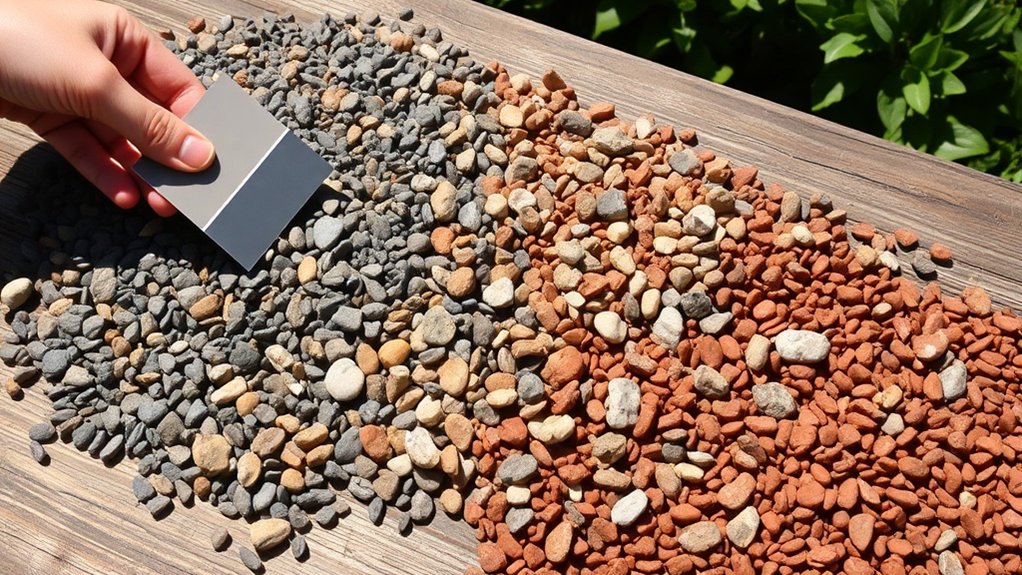
Have you thought about how the colour of gravel can enhance your driveway’s appeal? Choosing the right colour isn’t just about aesthetics; it’s about complementing your home’s style.
Earthy tones, such as brown or grey, blend well with natural surroundings and create a classic look. For a more contemporary feel, neutral shades like beige or off-white serve as a versatile backdrop that showcases your landscaping.
If you want to make a statement, vibrant colours can add personality, but ensure they coordinate with your home’s architecture to avoid clashes.
Also, consider colour psychology—lighter shades can brighten your space and keep it cooler in warmer weather.
Ultimately, choose colours that align with your vision while taking into account how they fit with the environment.
Maintenance Requirements for Different Gravel Types
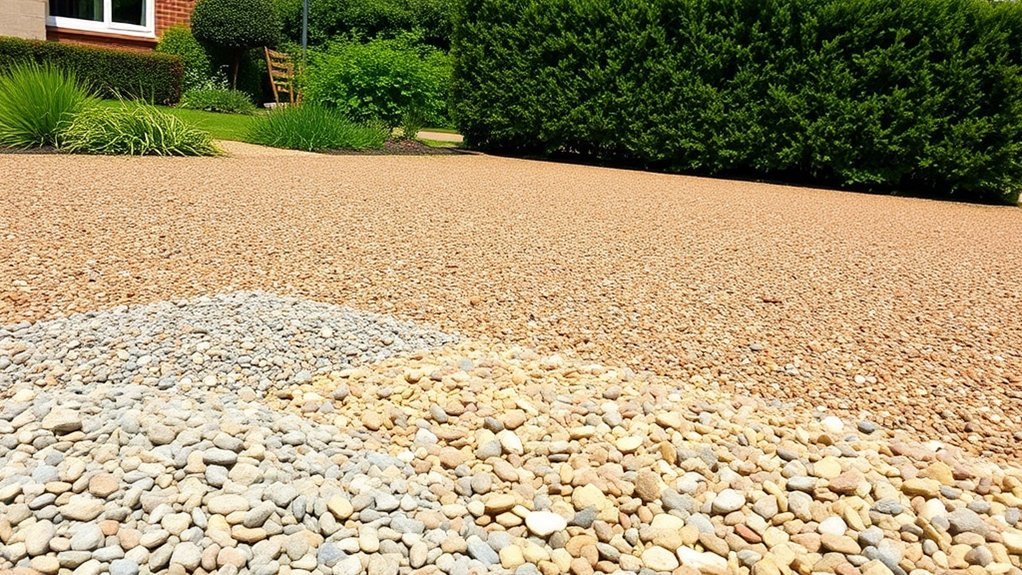
When it comes to gravel driveways, understanding maintenance requirements is essential for keeping your surface in good condition.
Different types of gravel have varying upkeep needs—some require regular raking and replenishing, while others need only seasonal attention.
For instance, a sharp gravel like limestone might need more frequent maintenance due to its tendency to scatter, while a rounded gravel like pea shingle is often more self-contained.
Gravel Maintenance Frequency
Gravel Maintenance Frequency
The type of gravel you select for your driveway significantly impacts your maintenance routine. Understanding these variations can save you time and effort.
Here’s a straightforward overview to help you assess maintenance frequency based on gravel durability and costs:
- Larger Crushed Stone: This type requires less frequent upkeep due to its excellent drainage and stability, which helps keep costs down.
- Pea Gravel: This option needs regular raking and replenishing as it tends to shift easily, leading to higher maintenance expenses.
- Reinforced Gravel Systems: These systems greatly reduce maintenance needs by preventing displacement and potholes, ultimately saving you money over time. Additionally, the use of permeable designs in gravel systems can enhance drainage and minimize flooding risks.
Leveling and Replenishing Needs
To keep your gravel driveway in top condition, it’s important to know how to level and replenish different types of gravel.
For crusher run, use effective levelling techniques and ensure thorough compaction for a stable surface.
Pea gravel, known for its smooth texture, requires regular levelling to prevent shifting.
When replenishing, always match the size and colour of your existing gravel to avoid unsightly patches.
Larger base layers need heavy compaction, while washed gravel must be handled carefully, as it can scatter easily.
With recycled concrete, consistency in colour is essential during replenishing.
Regularly topping up the surface layer helps maintain depth, but be careful not to overfill, as this can cause drainage issues.
Proper measurement and moderation are vital for a well-maintained driveway.
Seasonal Care Considerations
Maintaining your gravel driveway involves more than just leveling it out; seasonal care is crucial for its longevity and appearance. Here are some essential tips:
- Manage Seasonal Moisture: Different types of gravel absorb moisture differently. Ensure proper drainage to prevent erosion, especially during heavy rain or snowmelt.
- Weed Control: Regularly remove weeds in the warmer months to avoid disrupting the gravel. Use non-corrosive methods to keep the composition intact.
- Autumn Preparation: In autumn, clear away leaves and debris to reduce moisture retention and prevent fungal growth, helping your driveway stay in top condition.
Visual Impact of Gravel Colors on Driveway Design
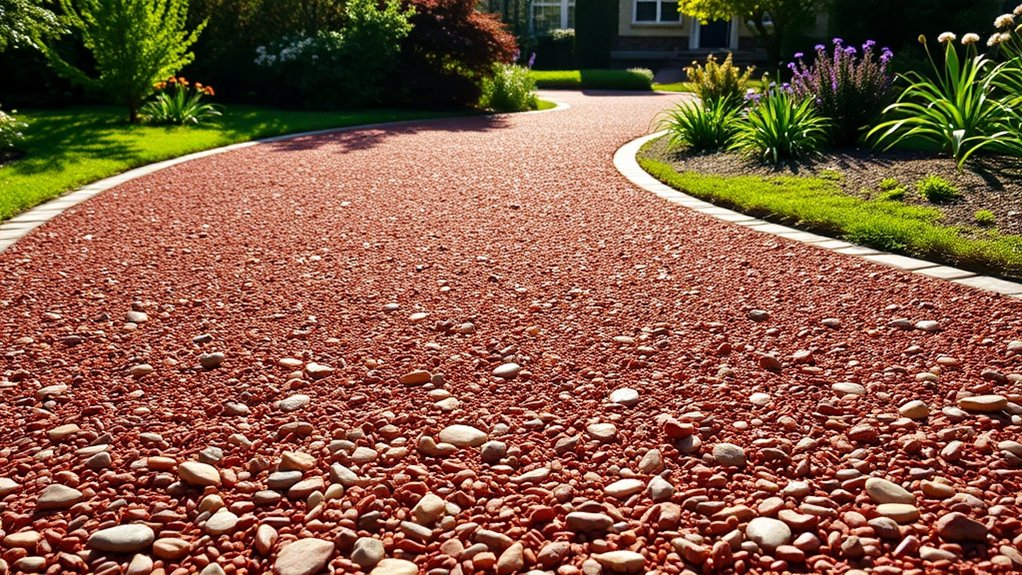
Selecting the right gravel colour for your driveway can significantly enhance its visual appeal and impact the overall look of your property. Warm earth tones like beige and brown create a rustic charm that suits traditional homes.
On the other hand, brighter colours such as red or blue can make a striking statement, especially with modern architecture.
You might also consider using different gravel patterns, like two-tone blends or herringbone layouts, to add interest and break up monotony. Mixing various gravel sizes can create texture, giving your driveway a more dynamic appearance.
Frequently Asked Questions
What Is the Cost Difference Between Various Colored Gravels?
The prices of coloured gravel can vary significantly. For instance, black gravel can cost as much as £11 per square metre, whereas white gravel typically ranges from £3.77 to £5.80 per square metre. It’s worth considering your options to achieve a good balance between aesthetics and budget.
How Do I Calculate the Amount of Gravel Needed?
To calculate the amount of gravel required, measure the dimensions of your driveway in metres. Multiply the length by the width and the depth to get the volume of gravel needed. Remember to convert measurements if necessary and allow for extra gravel to account for waste and compaction. For example, if your driveway is 5 metres long, 2 metres wide, and 0.1 metres deep, you’d need 1 cubic metre of gravel, plus a bit extra for good measure.
Can I Mix Different Colored Gravels?
Yes, you can mix different coloured gravels! Just ensure the colours work well together to create a pleasing aesthetic. For instance, pairing light grey gravel with darker shades can add depth and interest while keeping a cohesive look. This approach can enhance the overall appeal of your driveway or garden.
How Do I Prevent Weeds From Growing in Gravel?
To prevent weeds in gravel, place a weed barrier underneath and then add organic mulch on top. This blocks sunlight and improves the soil. Imagine a tidy, weed-free driveway that enhances your garden’s appeal without much effort.
What Tools Do I Need for Gravel Installation?
For gravel installation, you’ll need a gravel rake for leveling and spreading. Landscape fabric is essential to prevent weeds from growing through. It’s also a good idea to have shovels, wheelbarrows, and compaction tools on hand to ensure a durable finish.
Conclusion
Choosing the right colour gravel for your driveway can significantly impact the appearance and atmosphere of your home. Picture a warm, golden hue that reflects the sunlight, creating a welcoming vibe for visitors, or a sleek slate grey that conveys elegance. Your driveway serves as more than just a pathway; it’s an essential part of your property that should enhance your garden or surroundings. Selecting the appropriate colour can improve curb appeal and even boost your mood every time you come home.
Get inspired by the best block paving patterns for driveways that blend style and durability; discover which layout will elevate Read more
Keen to enhance your driveway with the right gravel? Discover the best types and find out which one suits your Read more
Understand the key factors for selecting the ideal driveway design for your property, and discover how to enhance both functionality Read more

